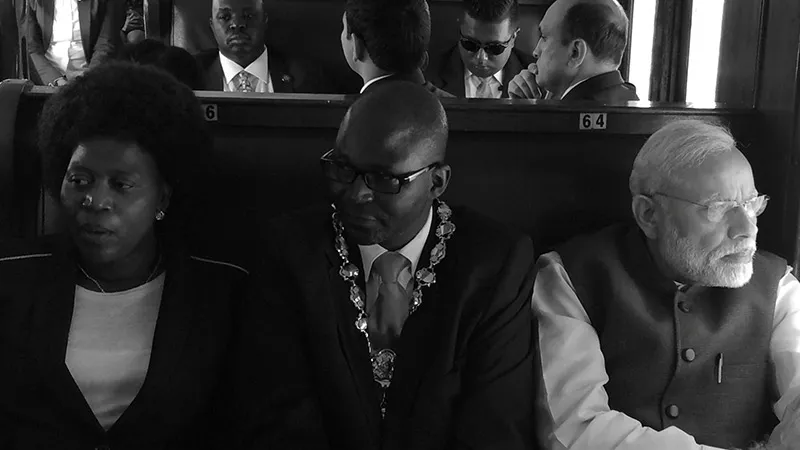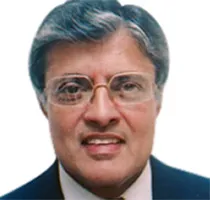-
CENTRES
Progammes & Centres
Location

The five-day four-nation African tour of Prime Minister Narendra Modi indicates a qualitative change in India’s engagement with Africa. The message that was conveyed goes far beyond the agreements signed and the new initiatives taken. The visit, by itself, adds great significance for several reasons:
There are also practical imperatives for such a visit. Foreign policies of most countries, particularly in Africa, follow a top-down approach. Gone are the days when diplomats and bureaucrats work out details of new initiatives for cooperation to be followed by high level visits. Today, it is the leaders who give the direction for new avenues. The decisions taken during such visits have a greater chance of speedy implementation thanks to the personal commitments of the leaders.
The choice of the four countries for Modi’s itinerary has a special strategic significance. All of them are Indian Ocean Rim countries meaning they are in our maritime neighborhood. Taken together with PM’s visits to Mauritius and Seychelles last year, it points to the new importance that India is attaching to the Indian Ocean Region which is becoming increasingly vital for our security. The problem of piracy in the Gulf of Aden and further south in the Indian Ocean has been a matter of great concern. The region is one of the busiest shipping routes and security of the Sea Lines of Communications are in the interest of the all the littoral states. India has been active in anti-piracy operations and has dedicated ships doing the job. Co-option of the four countries visited can enhance the efficacy of our operations. India would also be aiming to take on the role of a regional security provider which would be welcome in the region. Another aspect of importance to the littoral states is the concept of “Blue Economy”, a theme very close to Modi’s heart. This includes fishing and other economic activities connected with marine resources where India can have a win-win partnership with the four countries.
The threat of terrorism was also talked about during the visit. Kenya and Tanzania have been victims of terrorist attacks by religious fundamentalists of Al Shabab. Sharing of intelligence and coordination of anti-terror operations can benefit both sides.
The visit is also a major follow-up on the 3rd India-Africa Forum Summit (IAFS 3) held In New Delhi in October last year where all the 54 African countries participated and 41 of them were at the Head of State/Head of Government level. At the Summit, India had announced additional concessional credits of $10 billion over the next five years. Further, a grant assistance of $600 million was given including an India-Africa Development Fund of $100 million and an India-Africa Health Fund of $10 million. 50,000 scholarships over the next five years were also announced. The visit provided an opportunity to assess, at the highest level, the progress of the projects pertaining to the four countries.
In economic and commercial terms, the four countries have considerable importance. The trade between India and these countries is significant and growing. The figures respectively for Tanzania, Kenya, South Africa and Mozambique are $4 billion, $4.3 billion, $12 billion and $2.4 billion. The Foreign Direct Investment (FDI) is even more significant. Mozambique and Tanzania together account for $11 billion which is one-third of India’s total FDI to the African continent. India is working towards a major engagement in the energy sector with these two countries, coal and gas in Mozambique and natural gas in Tanzania. A new proposal to tap the agricultural potential of Mozambique was also pursued. It pertains to production of pulses there for export to India to meet the growing demand. This is a model that can be replicated in other African countries. The visit to Mozambique also marks a rare out-reach to Lusaphone (Portuguese speaking) Africa. The last such visit by an Indian PM was way back in 1982.
India’s traditional strength in cooperation with Africa has been in Capacity Building and Human Resource Development. In the past few years, Health sector has been added to the list. New assistance in both areas were extended during the visits to all four countries.
The highlights of the visit to Tanzania were the five agreements (two of them for Zanzibar) and PM’s interaction with the “Solar Mamas”—Tanzanian women workers trained in India or Indian assisted programs in making and use of solar lanterns. This activity has generated a multiplier effect with the Mamas training more and more women in a sustained manner.
Diaspora was another major factor in the tour. Of the four countries, three have significant numbers of Persons of Indian Origin (PIOs) — 1.5 million in South Africa (3% of the country’s population), 100,000 in Kenya and 60,000 in Tanzania. His addresses to 20,000 strong rally in Nairobi and 10,000 strong in Johannesburg were received with great enthusiasm by the diaspora.
Of the four, South Africa has other Indian connections like membership of groups such as G 20, BRICS, IBSA and. BASIC. South African companies have investments in India. It was reported that during the visit South Africa agreed to support India’s entry into the Nuclear Suppliers’ Group (NSG). After all the drama that took place on the issue a few weeks ago, this came as a positive outcome of the visit and removed a potential irritant in the bilateral relations.
What is needed now is to keep up the momentum in the engagement to convince Africa that India is a serious and dependable partner in the new industrialisation and development of the continent. Regular visits at least at the Cabinet Minister level have to be undertaken. Equally important would be high level visits in the reverse direction providing an opportunity for the African leaders to see India’s potential and identify areas of partnership. The most critical aspect is the speedy implementation of the initiatives taken. This has been the biggest problem in our partnership. At the IAFS 3, it was decided to put in place a high level monitoring mechanism with members from both sides to assess the progress and make course corrections, if needed. One only hopes that this mechanism is working well; otherwise, India-Africa Partnership cannot attain its true potential.
The views expressed above belong to the author(s). ORF research and analyses now available on Telegram! Click here to access our curated content — blogs, longforms and interviews.

H.H.S. Viswanathan was a Distinguished Fellow at ORF and a member of the Indian Foreign Service for 34 years. He has a long and diverse ...
Read More +